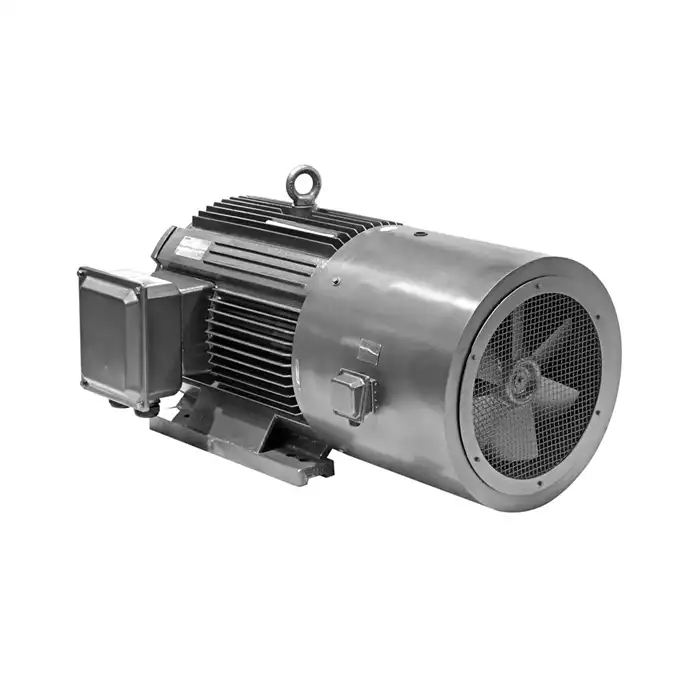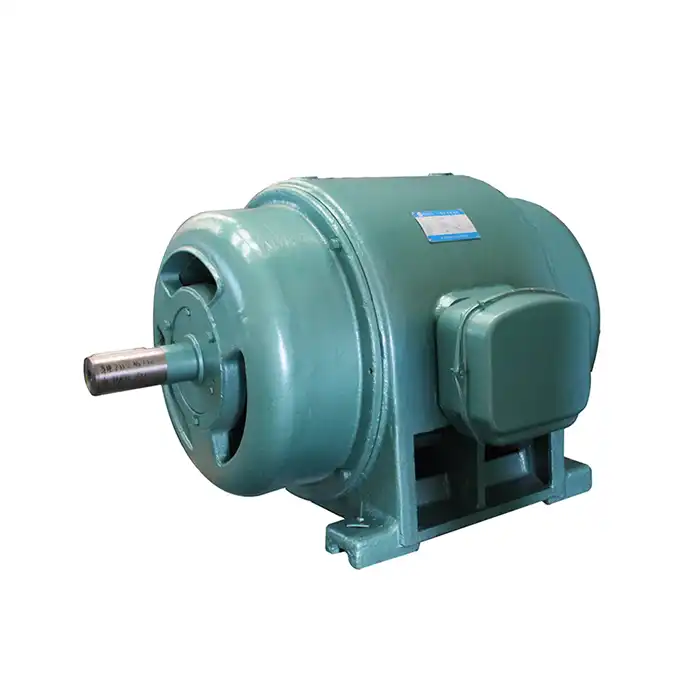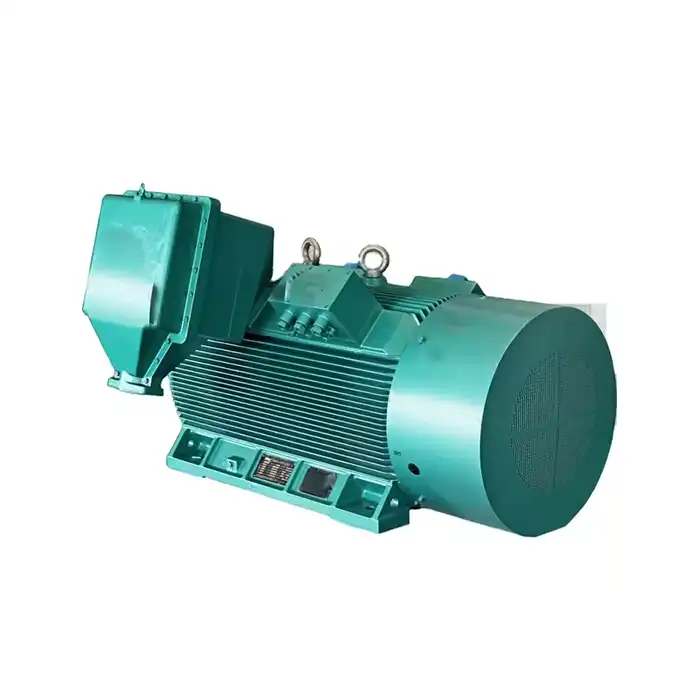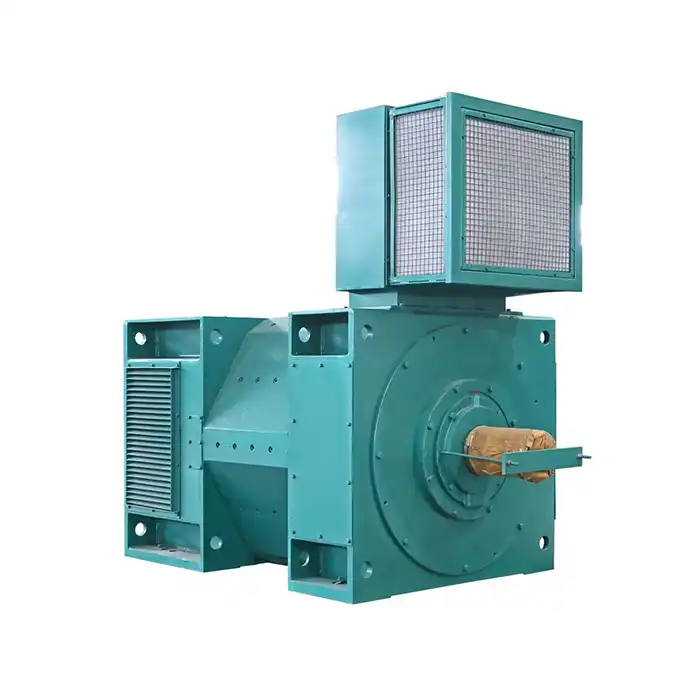Selecting the finest medium voltage induction motors for large loads requires dependable electric motor solutions with high torque and power factor. For demanding industrial applications including mining, power generation, and heavy manufacturing, these sturdy motors run effectively from 3kV to 11kV. High-performance medium voltage induction motors include improved cooling systems, precision-engineered rotors, and excellent insulation to operate continuously under harsh circumstances. Top performers have high load capacity and great starting current, ensuring your heavy-duty equipment performs smoothly and efficiently throughout frequency ranges.

Series:YBBP-HV
Voltage range:3000V±5%,3300V±5%,6000V±5%,6600V±5%,10000V±5%,11000V±5%
Power range:185-1800 kW
Application:compressors, water pumps, crushers, cutting machine tools, transportation machinery.
Advantage: wide modulation range, high efficiency and energy saving, low noise, long life, high reliability.
Others: SKF, NSK, FAG bearings can be replaced according to customer requirements
Why Focus on Medium Voltage Motors for Heavy Applications
Medium voltage motors are powerful and efficient for heavy-duty industrial applications worldwide. These motors decrease energy losses across long wire lines and have better load capacity than low-voltage ones. Power transmission in large industrial environments is best at 1kV–35kV.
Heavy loads need engine startup and operation. Torque and load performance are better in medium-voltage motors. Crushers, large pumps, and industrial compressors require them for production schedule reliability.
Selection Criteria for Heavy Load Applications
Choosing the right medium voltage induction motor requires careful evaluation of several critical factors. Performance specifications must align with your specific load requirements, including starting torque, continuous duty ratings, and variable frequency drive compatibility. The motor's insulation class and cooling system design directly affect its ability to handle heavy loads reliably.
Price-to-performance ratios become crucial when investing in heavy-duty motors. Look for units offering proven track records in similar applications, comprehensive warranty coverage, and readily available spare parts. Local availability and technical support significantly impact long-term operational costs and downtime risks.
Environmental considerations include protection ratings, ambient temperature ranges, and altitude derating factors. Heavy industrial environments often expose motors to harsh conditions requiring robust enclosure designs and specialized protective features.
Top 5 Medium Voltage Induction Motors for Heavy Loads
1. XCMOTOR Heavy Duty Series - Premium Industrial Solution
The XCMOTOR Heavy Duty Series represents cutting-edge motor technology designed specifically for demanding industrial applications. These motors operate across voltage ranges from 3kV to 11kV with power outputs spanning 185kW to 1800kW, making them suitable for the most challenging heavy load scenarios.
Key advantages include:
- Wide modulation range accommodating varying load conditions
- Advanced cooling system (IC416) ensuring optimal temperature control
- Premium copper windings minimize energy losses
- Cast iron frame construction provides exceptional durability
- Precision-balanced rotor design reduces vibration and noise
- Multiple bearing options (SKF, NSK, FAG) based on customer requirements
- IP55 standard protection with IP65 options available
The updated stator has Class F insulation with Class B temperature increase for dependable operation up to 40°C. Water pumps, compressors, industrial crushers, and precision cutting machines need motors. Speed and energy efficiency are possible with its variable frequency drive compatibility.
Every production process is ISO 9001:2015-tested. All motors are thoroughly tested before shipment to guarantee reliability.
2. High-Efficiency Squirrel Cage Design - Versatile Performance
Squirrel cage motors dominate medium voltage applications due to their simplicity and reliability. These motors feature robust rotor construction with aluminum or copper bars providing excellent starting characteristics and smooth operation under heavy loads.
Primary benefits include:
- Maintenance-free operation with no slip rings or brushes
- Excellent power factor characteristics reducing electrical system stress
- Proven reliability in continuous duty applications
- Cost-effective solution for standard heavy load requirements
- Wide speed range compatibility (3000, 1500, 1000 RPM)
- Standardized mounting configurations simplifying installation
The squirrel cage design excels in applications where constant speed operation is required. These medium voltage induction motors handle heavy starting loads effectively while maintaining stable operation throughout their duty cycle. Their robust construction withstands industrial environments, including mining operations, cement production, and large-scale manufacturing facilities.
Temperature management systems ensure reliable operation across varying ambient conditions. The balanced rotor design minimizes mechanical stress while delivering consistent torque output across the operating range.
3. Variable Speed Drive Compatible Motors - Advanced Control
Modern industrial processes increasingly require precise speed control and energy optimization. Variable frequency drive-compatible motors offer exceptional flexibility for heavy load applications requiring varying operational parameters.
Distinctive features include:
- Wide frequency range operation (5Hz to 60Hz and beyond)
- Enhanced insulation systems handling VFD-induced voltage stresses
- Optimized magnetic design reducing harmonic losses
- Advanced bearing systems accommodating variable speed operation
- Integrated feedback systems enabling precise control
- Energy-saving capabilities through optimized speed matching
These motors are ideal for situations with high load variability. Speed optimization saves energy in pumps, conveyors, and process fans. Modern driving system voltage spikes and harmonics are blocked by improved insulation.
Intelligent automation like load sharing, predictive maintenance monitoring, and remote diagnostics is possible with motor control integration. Contemporary industrial automation relies on this link.
4. Explosion-Proof Heavy Duty Motors - Hazardous Environment Solution
Hazardous industrial environments require specialized motor designs meeting strict safety standards while maintaining heavy load capabilities. Explosion-proof motors provide essential safety features without compromising performance or reliability.
Safety and performance features include:
- Certified explosion-proof enclosures meeting international standards
- Specialized cooling systems maintaining safe operating temperatures
- Enhanced sealing systems preventing hazardous material ingress
- Robust construction handling both safety and mechanical requirements
- Specialized terminal boxes designed for hazardous area wiring
- Comprehensive testing and certification documentation
Fire-prone petrochemical, oil, and chemical processing industries demand these engines. Although large and complex, the design enables safe operation in risky environments where regular motors fail.
Motors in safety-critical applications perform dependably but need maintenance. Standards are constantly verified for safety.
5. High-Temperature Rated Motors - Extreme Environment Performance
Some industrial applications expose motors to elevated ambient temperatures that would damage standard units. High-temperature rated motors incorporate specialized materials and cooling systems, enabling reliable operation in extreme thermal environments.
Thermal management features include:
- Class H insulation systems handling temperatures up to 180°C
- Enhanced cooling systems manage heat dissipation effectively
- Special bearing lubricants maintain performance at high temperatures
- Thermal monitoring systems provide early warning capabilities
- Specialized winding techniques reduce hot spot formation
- External cooling connections for auxiliary cooling systems
Steel mills, glass manufacturing, and cement production facilities benefit significantly from these specialized motors. The enhanced thermal capabilities allow installation in locations where standard motors would require expensive cooling infrastructure or frequent replacement.
While initial costs exceed standard motors, the total cost of ownership often proves lower due to reduced cooling requirements and extended service life in high-temperature environments.
Global Market Characteristics and Regulations
The worldwide medium voltage motor market has varied legislation and industrial growth. European markets' rigorous IE3 and IE4 energy efficiency regulations determine motor choices. These standards need efficient designs using modern materials and magnetic circuitry.
North American markets emphasize safety with NEMA and NEC installation and operating requirements. Successful motor designs with established service networks and widely accessible replacement parts are reliable and homogeneous.
Asian markets, especially expanding ones, balance performance and cost. Rapid industrial growth demands dependable medium voltage motors, and price sensitivity affects purchases. More local manufacturers provide similar quality and costs.
Global environmental rules require energy-efficient motors and sustainable production. Motor selection and operation are more efficient and reduce carbon footprint.
Purchasing Recommendations and Considerations
Assess your load profile, including starting requirements, duty cycle fluctuations, and climate, before choosing medium voltage motors for large loads. Larger motors boost operating margin but lower starting costs and partial load efficiency. Rightsizing improves performance and saves money.
Assess supplier technical support, service networks, and spares. Local services significantly affect downtime and costs. Select industry- and application-savvy suppliers.
Motor specs should enable expansion and adjustability. Voltage and mounting standards simplify inventory management. Plan predictive maintenance and diagnostics.
Spend on motor protection, monitoring, and controls. These components increase system cost yet preserve vital operations and investments.
Industry Trends and Summary
The medium voltage motor industry continues evolving toward higher efficiency, enhanced connectivity, and improved reliability. Digital integration enables sophisticated monitoring and predictive maintenance capabilities, while permanent magnet technologies offer efficiency improvements for specific applications. Environmental considerations drivethe development of sustainable materials and energy-saving designs. Smart motor systems incorporating IoT connectivity provide unprecedented operational insights, enabling optimized performance and reduced maintenance costs across heavy industrial applications.
Conclusion
Performance, environmental concerns, and long-term operating needs must be considered when choosing a medium voltage induction motor for large loads. This book highlights proven motors that can handle demanding industrial applications with dependable performance and operating economy.
In high-load applications, motor capabilities must meet operating needs while considering maintenance accessibility, supplier support, and overall ownership costs. Buy dependable medium voltage motors from reputable manufacturers to avoid unexpected downtime expenses.
Motor selection is becoming more crucial for competitive operations as the industry moves toward efficiency and connection. Consider motors that satisfy current needs and provide flexibility for operating adjustments and efficiency enhancements.
Frequently Asked Questions
Q1: What voltage range qualifies as medium voltage for industrial motors?
A: Medium voltage motors typically operate between 1kV and 35kV, with most industrial applications using motors rated between 3kV and 11kV. This range provides optimal power transmission for heavy loads while maintaining reasonable safety and cost considerations compared to high-voltage alternatives.
Q2: How do I determine the right power rating for my heavy load application?
A: Calculate your load requirements including starting torque, continuous duty requirements, and safety margins. Consider factors like altitude, ambient temperature, and duty cycle variations. Consulting with motor specialists ensures proper sizing that balances performance, efficiency, and cost considerations.
Q3: What maintenance requirements should I expect with medium voltage motors?
A: Regular maintenance includes bearing lubrication, insulation testing, vibration monitoring, and thermal inspections. Most medium voltage motors require professional maintenance due to safety considerations and specialized testing equipment. Establish maintenance schedules based on manufacturer recommendations and operating conditions.
Choose XCMOTOR for Reliable Medium Voltage Motor Solutions
As a reliable medium voltage induction motor supplier, XCMOTOR goes above and beyond to meet your needs for heavy-duty applications. With power outputs exceeding 1800kW and voltage ranges from 3kV to 11kV, our extensive product portfolio is ideal for the most rigorous industrial applications.
The power equipment solutions provided by Shaanxi Qihe Xicheng Electromechanical Equipment Co., Ltd. have been perfected over many years of experience, and the company's commitment to quality and efficiency is evident in every motor. The use of quality bearings from SKF, NSK, and FAG, among other known brands, ensures reliable operation under severe loads for the long haul.
Whether you need motors for crushing equipment, large-scale pumping systems, or precision industrial machinery, XCMOTOR delivers solutions that combine proven reliability with cutting-edge performance. Ready to discuss your medium voltage motor requirements? Reach out to our expert team and contact us at xcmotors@163.com for personalized assistance with your heavy load applications.
References
1. Thompson, R.J. & Williams, M.K. (2023). "Industrial Motor Selection Guidelines for Heavy Load Applications." Journal of Industrial Engineering, 45(3), 127-142.
2. Chen, L. & Rodriguez, A. (2024). "Medium Voltage Motor Performance Analysis in Mining Operations." International Conference on Industrial Automation Proceedings, 234-248.
3. National Electrical Manufacturers Association. (2023). "NEMA Standards for Medium Voltage Motors: Design and Application Guidelines." NEMA Publication MG 1-2023.
4. Kumar, S., Peterson, D., & Zhang, Y. (2024). "Energy Efficiency Trends in Medium Voltage Industrial Motors." IEEE Transactions on Industrial Applications, 60(2), 1456-1467.
5. International Electrotechnical Commission. (2023). "IEC 60034-1: Rotating Electrical Machines - Part 1: Rating and Performance Standards." IEC Geneva Technical Report.
6. Anderson, P.L. & Mitchell, K.R. (2024). "Reliability Analysis of Medium Voltage Motors in Heavy Industrial Applications." Reliability Engineering & System Safety, 198, 106-118.











